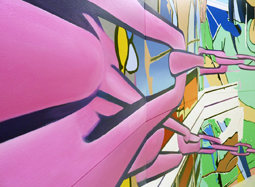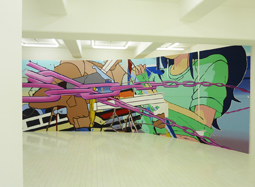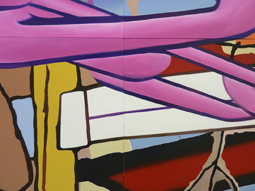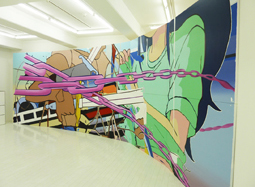 |
|
 |
| Detail of Sirius -- the large-format piece was produced on ten canvas panels. |
|
Over two meters high and eight meters wide, Sirius commands the display space at Nanzuka Underground. |
Shirokane Art Complex has been a discreet presence in the high-end residential Tokyo neighborhood of Shirokane-Takanawa for the past three years. Within the renovated five-story apartment building are galleries that have moved from their previous location in Kagurazaka, including the Kodama Gallery, Yamamoto Gendai, and Takahashi. Currently on display at a more recent addition to the art complex, Nanzuka Underground, is the second solo show by self-proclaimed "outsider" Tomoki Kurokawa. Originally from Mie Prefecture, this self-taught artist now lives and works out of his studio in Saitama.
As the elevator doors open directly into the gallery, visitors are greeted with an intense, glaring light. Every surface within the space, including the floor, walls and ceiling, has been painted a bright white, requiring some time for one's eyes to adjust. That is when attention is drawn to the main piece on display, entitled Sirius. At two and a half meters high and just over eight meters wide, this mural-sized oil painting spans two walls, curving gently at the corner. The piece is made up of ten canvas panels which Kurokawa has spent the last year completing. Three smaller pieces -- two sketch studies for Sirius and a small untitled painting -- are also on display in a separate alcove at Nanzuka Underground.
Sirius portrays two figures: one armored and beast-like, the other a young woman; together they are enveloped by a pink chain. The woman seems to be lifting her shirt while getting run through by a sword, but we are not quite sure. The composition is seductive and dynamic, causing the viewer's eyes to move all over the piece in a vain attempt to determine what is happening. Some areas are rendered very literally while others are abstract. The cropping of the figures by the frame makes the already large-scale work seem even larger.
The panels reveal details of action that border on slow motion at times, then rapidly zoom in and out, the kind of visual tricks often used in manga illustration. Kurokawa demonstrates confidence in his color choices and his use of line and shadow. And clearly he is not afraid to go large. Paintings in his previous series 3m, Youth and Play Room range in size from 50 cm up to two meters. As in Sirius, these earlier works pay homage to media culture, cartoon and videogame imagery, while individual pieces make flickering references to Lichtenstein, Kandinsky and Dali. Compositionally his work has parallels with early 1920s Russian constructivism and the propaganda posters of that era that might be called socialist realism. Whether Kurokawa's work is driven by a social agenda is not entirely clear, yet in his writing he does refer to raising the viewer's consciousness through what he calls "trash painting."
Every day we face a barrage of images, most of them fleeting, or as Kurokawa would say, abandoned. Trash painting is his way of creating value from nothing, pursuing the potential of what is otherwise overlooked. Sirius does not literally use found objects as its medium; rather it is a painted montage of the images that Kurokawa has encountered in magazines, ads, and on the Internet -- a sort of imagery dumpster dive. His work may be seen as a commentary on our society of consumption.
Kurokawa refers to his unorthodox career as a metaphorical blank canvas on which to pursue new challenges. He has a promising future and an endless supply of imagery to be inspired by. Indeed, there is something gratuitously apologetic about continually pointing out that he has no formal art training. His lack of formal training is irrelevant: many artists throughout history have been self-taught. Likewise, an art degree doesn't guarantee a thriving artistic career. It is not an accident that Kurokawa creates stunning, evocative pieces. He is a talented artist, no qualifier necessary.
 |
|
 |
Detail of Sirius -- a vivid, confident choice of colors.
|
|
A small line drawing study for Sirius.
|
 |
|
 |
Kurokawa has created a dynamic composition that seems at times to zoom rapidly, then suddenly hang in slow motion.
|
|
Only about 15 cm square, Untitled displays Kurokawa's range in scale and subject.
All photos by Nicolai Kruger with the permission of Nanzuka Underground.
|
|